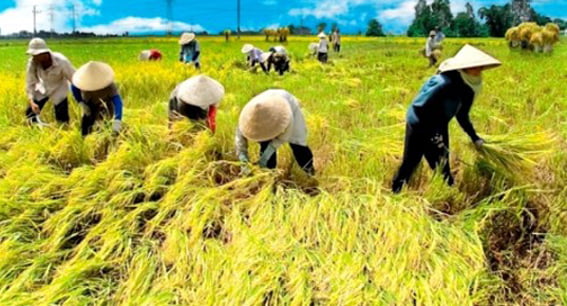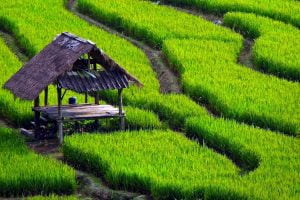
The President of the Republic of Indonesia issues Government Regulation (PP) Number 65/2019 concerning Guaranteed Agricultural Land Extensions. This PP was set on September 19, 2019 and promulgated on September 23, 2019.
Reading this PP, it seems that there is a great desire from the Indonesian government to keep agricultural land available; so that farmers can work joyfully on agricultural land; and so that they also get a decent living from farming. The main goal is the availability of adequate food for all Indonesian people towards food self-sufficiency.
It must be acknowledged that the issuance of this PP is a breakthrough attempt by the Government to address the continued decline of food agricultural land. In 1983 the area of paddy fields in Indonesia was around 16 million hectares, in 2013 it decreased to 8 million hectares, in 2017 there were 7.75 hectares, and in 2018, according to the Central Statistics Agency (BPS), paddy fields in Indonesia were only 7.1 million hectares (CNN Indonesia, 10/25/18). This is naturally a concern of all parties, because the decline of the area of rice fields occurred in the midst of a population that continues to grow, while the population is still dependent on rice. The strong dependence on imported food will disrupt food sovereignty, and will be vulnerable to social, economic and political crises.
The breakthrough made by the government, through this PP, is to make it easy for farmers to obtain: (a) state owned land designated as agricultural areas; and (b) Agricultural land originating from ex-abandoned land which is determined and potentially becomes agricultural land. Another breakthrough is to provide easy capital acquisition for farmers who are interested in working on the state-owned land through a bank loan scheme.
The government can provide farmers with ease of use of the land in the form of concessions, management or utilization permits. That is, by ownership, the land remains state property; farmers are only entitled to work on, manage, or use the land.
Requirements to Become a Cultivating Farmer
Not all farmers are entitled to obtain the arable land, but there are certain conditions. As stipulated in Article 4 points 1-3, the maximum area of land that can be cultivated by each farmer is 2 hectares. Prospective cultivators have carried out farming activities for at least 5 years. The prospective cultivator does not own land, but has been a smallholder farmer for at least five years, with a maximum of 2 ha of arable land; or land owner farmers with a maximum area of 2 ha, and have been working on the land for at least 5 years.
Ease of obtaining agricultural land is also given to horticultural farmers, planters, or small scale business farmers in accordance with statutory provisions
Another requirement is that prospective tenants reside in the same sub-district as the agricultural land to be worked on. This can be proven by the identity number card and family card owned by prospective cultivators.
Land Acquisition Procedure
The farmers who are interested in working on state-owned land do not just get it immediately, but must go through established procedures. Prospective cultivators must submit a request to the regent/mayor by attaching a photocopy of the domicile card, a statement that has been doing farming for five years validated by head of local village (lurah), the statement that has worked on state-owned land for farmers who have worked on state owned land, and statement letter as a member/has joined a farmer group.
By the permit request, the regent/mayor will verify, and issue permits for proposals that meet the requirements, after coordinating with the local land office. Furthermore, farmers who have obtained a permit must apply good farming methods, good harvesting methods, and good agricultural processing methods.
Young Farmers, not Senior Farmers
Observing the requirements for applying for the land use permit, especially the requirement that farmers have actively worked on agricultural land for at least five years, the possibility of those who will apply is senior farmers, who are above 40 years old. Factually, the active farmers in Indonesia are senior farmers. According to the LIPI survey, the average age of farmers in Indonesia is above 45 years. More clearly, the study by the Research Center for Population, the Institute for Indonesian Science (LIPI) shows that the average age of farmers in three rice farming villages in Central Java is 52 years, whereas the young people who are willing to continue the family farming business there are only around 3%. “Reflecting from the results of this survey, if in the future the condition remains unchecked, then Indonesia will face a farmers’ crisis,” said Romdiati, a LIPI researcher (Quoted from Viva.co.id., October 25, 2019). If there are other jobs outside the agricultural sector, farmers will prefer other sectors. Jobs in the agricultural sector will be put aside. The research of Losvitasari et al. (2017) in the Tanah Lot Tourism Area, Tabanan, Bali, shows the lack of interest in farming among young people who are used to tourism activities. Instead, they prefer to work in the tourism sector because they are more prestigious and earn more; whereas Tabanan is one of the centers of food production in Bali.
The research of Maman et al. (2017) was conducted on young farmers who own land in Gekbrong Subdistrict and Warung Kondang, Coianjur Regency, West Java, whose land is still intact but around that a lot of land has been converted into various uses outside the agricultural sector. The result, it is very worrying. About 80% of young farmers have low and moderate perceptions on the practice of rice farming, both in the pre-planting phase, the phase of soil cultivation & crop maintenance, and the harvest & post-harvest phase. A moderate perception among young farmers is a high risky because it can turn to negative perceptions of farming practices.
The low interest of youth in farming does not only occur in the food agriculture sector, but also in the horticulture sector. UGM Professor, Irwan Abdullah, complained about the low involvement of young people in cocoa farming. It was mentioned, the age group of 18-24 years who participated in cocoa plantations was only 4%, and the 25-31 years group was 21%. The percentage of youth involvement to help parents/other parties in cocoa farming sector also shows a low number. In the 18-24 and 25-35 years age groups, participation was only 31% and 25% (SurveyMetter, 25 October 2018)
Tend to Sell Land
Farming unwillingness strongly induces the farmers to sell their agricultural land. Thus the results of research conducted by Maman et al. (2017) in two sub-districts of Gekbrong and Warung Kondang, Cianjur Regency, West Java, to the young farmers who own land. The results of the research that showed the same tendency were also seen in the case study conducted by Dwipradnyana (2014) in Subak Jadi, Kediri, Tabanan, Bali. About 85% of sample farmers are of the view that agricultural land never yields the expected results (Dwipradnyana, 2014). This is in line with research of Losvitasari et al. (2017) in which it was also conducted in Tabanan that farmers who are accustomed to benefit from tourism activities have low enjoyment, interest and involvement in the agricultural sector.
The Need for Policies to Foster Farming Interest
As a result, to maintain the sustainability of food agriculture in Indonesia, the breakthrough that needs to be done is not to emphasize the provision of agricultural land, but the most important is to foster farming interest among younger generation. If there is already growing interest in farming supported by skills, then the provision of land is a necessity. That is, the Government Regulation on Agricultural Land Coverage is not enough but a government regulation is needed that specifically regulates the development of the younger generation to enter the world of agriculture.
Food procurement and provision of various facilities and infrastructure needed – including the formation of human resources working in agricultural sector – should be handled directly by Government. As is known, that the business in the rice agriculture sector – especially on farm – does not provide maximum benefits, so it needs strong policies and a high desire to maintain the sustainability of food agriculture activities. In this case we can imitate the management of Prophet SAW. He as the head of state directly provides human resources for farming, providing and managing food agricultural land, especially those originating from state-owned land, overseeing the food production process to avoid irregularities; and carry out food distribution by the state and monitor it closely. On the other hand, he encourages individuals to want to use their land to farm, but it is fully an optional right of the land owner.***
Reference
CNN Indonesia, 10/25/18
Dwipradnyana, I.M.M. 2014, Faktor-Faktor Yang Mempengaruhi Konversi Lahan Pertanian Dan Pengaruhnya Bagi Kesejahteraan Petani: Studi Kasus Di Subak Jadi, Kediri, Tabanan. Tesis Universitas Udayana.
Losvitasari, N.M. Diarta, I.K.S, Suryawardani, I.G.A.O. 2017. Persepsi Generasi Muda terhadap Minat Bertani di Kawasan Pariwisata Tanah Lot: Kasus Subak Gadon III, Tabanan, E-Jurnal Agribisnis dan Agrowisata. 6(4):477-485.
Maman U., Nindyantoro, dan Margono, T.T. 2017a, Initiating the Model of Wet Rice Field Management to Optimize Staple Food Availability: An Explorative Study in Cianjur Farming Area. Laporan Hasil Penelitian Yang Belum Diterbitkan.
SurveyMetter, 25 October 2018
Viva.co.id., October 25, 2019



